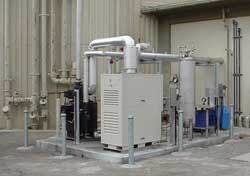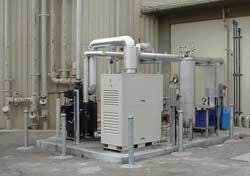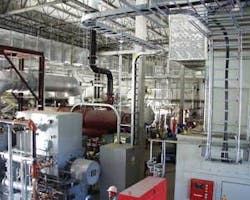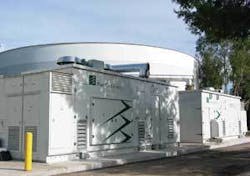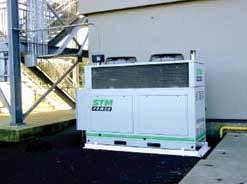Cogeneration gains favor for municipal wastewater treatment operations
Engineer Sarwan Wason of the US consultancy Carollo Engineers explores current trends in cogeneration and considerations to keep in mind when deciding upon on-site power cogeneration systems for wastewater treatment facilities.
On-site power generation systems (cogeneration) for municipal wastewater treatment facilities are increasingly attracting attention from municipalities given the rising cost of energy. In the USA, interest in cogeneration is expected to grow in importance especially in western and southern states. Some of the factors driving this trend at wastewater facilities are the need for standby power (during utility power outages) for reliability; high energy prices; availability of free fuel (digester gas [DG]); and significant grants and incentives being offered by states and federal governments to encourage green or bio energy from renewable resources. These factors are making cogeneration much more cost-effective even for smaller wastewater facilities than in past years.
Digester gas in wastewater treatment plants contains 60 to 65 percent methane, 35 to 40 percent CO2, and other contaminants including H2S, siloxanes, grease, dirt, and is saturated with water vapor. Varying level of gas treatment is required depending on the cogeneration technology.
Government grants make cogeneration projects more cost-effective, especially in the US state of California, where the current grants are about US $1,000/kW for reciprocating internal combustion (IC) engines, $1,300/kW for microturbines, and $4,500/kW for fuel cells on renewable fuels like DG and landfill gas (LFG).
Need for standby power also makes cogeneration more cost effective. In the economic analysis, the cost of standby power can be deducted from the cost of cogeneration before evaluating payback period or net present value.
The cogeneration technologies currently being considered are IC engines, microturbines, gas turbines, fuel cells, and Stirling engines. A brief description of the latest developments of these technologies, including applications of the equipment, provides a current overview of available cogeneration options.
IC engines
Reciprocating IC engines is the most common and proven technology for wastewater treatment plants using DG fuel. Lean-burn, spark-ignited, turbo-charged and inter-cooled engines are normally used, which offer low nitrogen oxide (NOX) emissions able to meet emissions regulations of local air districts. Duel-fuel compression ignition (no spark plugs) engines have also been used with diesel pilot fuel for larger size cogeneration facilities, however, they have higher emissions. IC engines are normally used for sizes from 250 to 2,500 kW. Manufacturers are Waukesha, Caterpillar, Jenbacher and Deutz. Electricity conversion efficiency ranges from 25 percent to 35 percent. The overall efficiency including lube oil, jacket water and exhaust heat recovery could be 70 percent to 80 percent. Siloxane in DG is a significant maintenance issue. Engines with low-pressure fuel system requiring less than two psig pressure are also available.
One of Carollo Engineers’ projects at the City of Sunnyvale wastewater treatment plant in California, employs two 800 kW Caterpillar gas engines using DG, LFG, and air-diluted NG as fuel with heat recovery. Landfill is located near the facility and is also owned by the City of Sunnyvale. Cogeneration facilities at East Bay Municipal Utility District in Oakland, California with 3-2,150 kW DeLaval Enterprise compression ignition engines uses 100 percent DG. Carollo Engineers is currently designing an expansion of this facility from 6.5 megawatts (MW) to 15 MW with consideration for a future increase to about 20 MW. Carollo Engineers is a consultancy based in Walnut Creek, California, USA.
Microturbines
Microturbines are miniature industrial gas turbines. Units currently available with DG experience are 30 kW and 60 kW (by Capston) and 70 kW and 250 kW (by Ingersoll Rand). Electricity conversion efficiency is enhanced by using recuperation cycle where most of the exhaust gas heat is used to preheat the combustion air charge. There is still plenty of heat, which can be recovered as hot water for digester heating.
The electricity conversion efficiency ranges between 25 to 30 percent. The overall efficiency, including heat recovery, could be as high as 70 percent. Because of the small clearances and high speed of small rotor blades, fuel gas specifications require near complete removal of all deposit-forming siloxanes in the DG. The microturbines have very low emissions and permitting is relatively easy. Microturbines require over 50 psig fuel pressure. Figure 3 shows another Carollo project with 30 KW DG-fueled Capston microturbine installation at the Novato sanitary district wastewater treatment plant in Novato, California.
Gas turbines
Gas turbines using DG or LFG as fuel are cost-effective for cogeneration facilities over 3,000 kW size. Two manufacturers -- Solar and Allison -- have digester gas experience. Gas turbines are required to meet strict air permit regulations. Removal of siloxanes and hydrogen sulfide are issues for maintenance considerations. Electricity conversion efficiency is 30 to 38 percent. The higher efficiency is achieved either with recuperated turbines or with using combined cycle (gas turbine followed by steam turbine). The overall efficiency including heat recovery could be 70 to 80 percent. Gas turbines require over 200 psig fuel pressure. This extra compression energy needs to be considered in the evaluation when comparing alternatives. Carollo completed the eight-MW DG/NG -fueled solar gas turbine/steam turbine cogeneration plant in King County, Seattle, Washington, for their Renton wastewater treatment plant.
Fuel cells
Fuel cells produce electrical energy from gaseous fuel without combustion like a chemical battery. Fuel cells are highly efficient and have negligible emissions; therefore most air districts do not require a permit for fuel cells. Fuel cells are available in 200 to 250 kW modules in size from two manufacturers - Fuel Cell Energy (FCE) and United Technolo-gies Corp (UTC). More than 30 units have been operating on natural gas since 1995. Numerous have been placed in operation on digester gas in the last couple of years. Because of the availability of high grant money (US$ 4,500 per kW for digester gas) in California, many energy companies have expressed strong interest in fuel cells.
Electricity conversion efficiency is 35 to 50 percent with overall efficiency, including heat recovery, in the 70 to 80 percent range. Fuel cells require extreme fuel conditioning to remove siloxanes, hydrogen sulfide, and other contaminants in digester gas. Fuel cells have high capital cost and maintenance costs (for fuel cell stack replacement every three to five years). Fuel cells using digester gas are getting just as cost-effective as IC engines and microturbines with the high amount of grant money available in California. A project completed by Carollo in the City of Tulare has recently been approved for 750-kW fuel cells on digester gas.
Stirling engines
Stirling engine technology has been around a long time, but up until recently has not been commercialized in power generation applications. They have been used routinely in spacecraft and military applications, and small appliance applications. STM Power, Inc. is currently the only manufacturer of Stirling Engine generator systems. They currently produce a 55-kW unit and have plans for a 75-kW unit ultimately increasing to 250-kW units. The units are reciprocating engines in which combustion takes place outside of the piston in a manner very similar to a boiler. The combustion products heat up a working fluid inside the piston. As a result, the units can operate on a wide range of low BTU gaseous fuels without the need for fuel compression or pre-cleaning being necessary. The electrical efficiency of the units is approximately 30 percent and the overall efficiency, including heat recovery, is approximately 80 percent.
The combustion process is continuous and occurs at a constant temperature and pressure, so it can be controlled for maximum fuel flexibility with very low emissions. Nitrogen oxide (NOx) and unburned hydrocarbon emissions are lower than for internal combustion engines. No catalytic converter or other exhaust treatment is required. Exhaust emissions are similar to those of boiler systems. Expected maintenance costs are lower than other technologies. Required fuel pressure is less than 1 psig.
